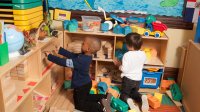9 Picture Books About Cleaning Up
These resources, including entertaining picture books, can help teach very young students the importance of cleaning up after themselves.
Your content has been saved!
Go to My Saved Content.Ask most early childhood teachers and parents/caregivers about “cleanup time,” and watch for commencing eye-rolls. Listen for corresponding phrases such as “I wish they would clean up“ or “They really should clean up.”
Now, carry that perspective through to the beginning of the school year. A new crop of young students and sometimes new teachers, unfamiliar with the classroom and each other, must now collaboratively clean up after independent play. Is it possible to be good at a task that you have limited experience doing, much less participate cooperatively to efficiently get the job done? Probably not.
Especially at the beginning of the school year, cleanup time requires intentional instruction to give students the necessary procedural information, and clear labeling can assist their visual understanding of where items belong in the classroom. Young children additionally need ongoing opportunities to process this activity throughout the school year to learn and apply skills and strategies for returning class materials as individuals as well as a group.
While this article isn’t a recipe for the perfect cleanup time, it does suggest resources that will help in assisting initial and ongoing discussions and problem-solving for maintaining classroom organization. The Responsive Classroom offers a short but helpful video that models the transition to cleanup time, titled Teacher Language at Clean-Up Time. Each picture book below about cleaning up also includes the social and emotional learning (SEL) and math themes featured in each title.
Picture books about cleanup time
Reading these books as part of an early morning meeting allows children to consider and adopt strategies from the book to apply to a later hands-on opportunity in the classroom.
Little Tiger Picks Up, by Michael Dahl, illustrated by Oriol Vidal. Big Tiger says it’s time to pick up the books and toys spread around the room. Little Tiger lets out a frustrated “roar” but ultimately sorts and returns each item to a designated place in the room. Features the early childhood math concepts of sorting and classifying and includes the individual social and emotional challenges and rewards of putting things away. (Preschool)
Gray Rabbit’s Favorite Things, by Alan Baker. Gray Rabbit can’t find his favorite book hidden in his mound of toys. Rabbit sorts and classifies toys and is ultimately rewarded with both the discovery of his book and a much-deserved nap. Features the early childhood math concepts of sorting and classifying. (Preschool–kindergarten)
Little Oink, by Amy Krouse Rosenthal, illustrated by Jen Corace. In this turnabout tale, Little Oink the pig loves everything neat and orderly; his parents expect Little Oink to be suitably messy and disorganized. At school, Little Oink finds strategies to do messy things that his peers do, but in his own tidy way. At home he follows his parents’ rules but also finds refuge in his immaculate tree house. Addresses the individual social and emotional challenges and rewards of putting things away. (Preschool–kindergarten)
Llama Llama Mess, Mess, Mess, by Anna Dewdney and Reed Duncan. Mama says it is cleaning day, but Llama Llama wants to continue playing. Llama Llama’s mama tells him that everyone has jobs to do; she suggests, and Llama Llama imagines, what the house would look like if Mama never cleaned. Ultimately, they clean up together and then celebrate by putting together a puzzle. Highlights the SEL goal of collaboration and addresses the individual social and emotional challenges and rewards of putting things away. (Preschool–kindergarten)
Stanley’s Toy Box, by William Bee. Stanley the hamster brings his toy box to the park. Stanley and his friends Little Woo and Betty play with toys from the box and then collaborate to put them away at the end of the play date. Features the SEL goal of collaboration. (Preschool–kindergarten)
A Mousy Mess, by Laura Driscoll, illustrated by Deborah Melmon. When the people are away, the mice will play! Albert the mouse, his sister Wanda, and his friend Leo investigate the family playroom stocked with blocks, marbles, balls, and trains. Albert gets carried away, and all of the toys spill onto the floor. Will Albert and his friends be able to put things where they were before the family and their cat Groucho return? Of course they will—with a little teamwork. Features the SEL goal of collaboration and the early childhood math concepts of sorting and classifying. (Preschool–grade 1)
Julia’s House for Lost Creatures, by Ben Hatke. Julia’s house is a bit too quiet, so she posts a sign outside her door that says, “Julia’s House for Lost Creatures.” Immediately, a stream of fantastical creatures move right in. When creativity and chaos consume her orderly house, resourceful Julia creates a “Chore Chart” to divide up household responsibilities. Highlights the SEL goal of collaboration and addresses the individual social and emotional challenges and rewards of putting things away. (Preschool–grade 2)
Problem Solved! by Jan Thomas. Rabbit’s big green room is very cluttered. Porcupine Pete, the Problem-Solving Porcupine, has solutions for Rabbit; however, the solutions are completely nonsensical, and while Rabbit frantically undoes all of Pete’s “problem-solving,” Rabbit has a tidy room, but the problem is now Porcupine Pete. Can a solution be out there somewhere? Features the early childhood math concepts of sorting and classifying and addresses the individual social and emotional challenges and rewards of putting things away. (Preschool–grade 2)
Zippy Messes Up! by Anitha Balachandran. On a rainy day, Zippy and his animal friends head inside to play in his bedroom. The friends engage in a variety of activities—some independent and others with friends. When it’s time to clean up, they work together as a team to restore order to Chiki’s room. Highlights the SEL goal of collaboration. (Preschool–grade 2)
